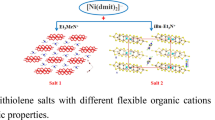Abstract
Two metal-dithiolene compounds with a formula of [Cn-py][Ni(mnt)2] (Cn-py+ represents the 1-alkyl-pyridinium cation, n = 8 (denoted as compound 1), and 9 (denoted as compound 2); mnt2− = maleonitriledithiolate) were synthesized and characterized. The crystal structures determined for two compounds disclosed that these are isostructural with similar cell parameters and packing structures. The cation adopts a bent conformation and the direction of the hydrocarbon chain is approximately parallel to the long molecular axis of the [Ni(mnt)2]− anions, and the [Ni(mnt)2]− anions and cations of 1 and 2 form segregated irrequidistant columns stacks along the crystallographic c-axis direction. It is worth noting that there existed charge assisted C–H···N interactions between the adjacent anion and cation stacks in crystal of 1 and 2. DSC measurement of 1 and 2 exhibited two exothermic peaks in the first and second cooling process, and showed supercooling behavior and the thermal hysteresis of 18 and 50 K were observed for 1 and 2, respectively. Furthermore, 1 exhibits cold crystallization around 342 K during the second heating scan. Compound 1 shows the magnetic characteristics of a low-dimension antiferromagnetic coupling spin system in the high temperature and spin gap in the low-temperature phase, and compound 2 exhibits weak paramagnetism over the temperature range of 2–400 K.
Graphical Abstract
Compound 1 shows the magnetic characteristics of spin gap in the low-temperature phase and 2 exhibits weak paramagnetism over the temperature range of 2–400 K.







Similar content being viewed by others
References
Bray JW, Hart HR, Interrante LV, Jacobs IS, Kasper JS, Watkins GD, Wee H, Bonner JC (1975) Phys Rev Lett 35:744
Jacobs IS, Bray JW, Hart HR, Interrante LV, Kasper JS, Watkins GD, Prober DE, Bonner JC (1976) Phys Rev B 14:3036
Andrieux A, Jerome D, Bechgaard KJ (1981) Phys Lett 42:87
Forro L, Bouffard S, Pougest JPJ (1984) Phys Lett 45:453
Caneschi A, Gatteschi D, Lalioti N, Sangregorio C, Sessoli R, Venturi G, Vindigni A, Rettori A, Pini MG, Novak MA (2001) Angew Chem Int Ed 40:1760
Clérac R, Miyasaka H, Yamashita M, Coulon CJ (2002) Am Chem Soc 124:12837
Ueda Y (1998) Chem Mater 10:2653
Azuma M, Hiroi Z, Takano M (1994) Phys Rev Lett 73:3463
Krogmann K, Hausen HD (1968) Z Anorg Chem 358:67
Kahn O (1993) Molecular Magnetism. VCH, Weinheim
Ren XM, Nishihara S, Akutagawa T, Noro S, Nakamura T (2006) Inorg Chem 45:2229
Ren XM, Nishihara S, Akutagawa T, Noro S, Nakamura T, Fujita W, Awaga K (2006) Chem Phys Lett 418:423
Duan HB, Ren XM, Meng QJ (2010) Coord Chem Rev 254:1509
Pei WB, Wu JS, Ren XM, Tian ZF, Xie JL (2012) Dalton Trans 41:2667
Duan HB, Ren XM, Shen LJ, Jin WQ, Meng QJ, Tian ZF, Zhou SM (2011) Dalton Trans 40:3622
Davison A, Holm HR (1967) Inorg Synth 10:8
Software packages SMART and SAINT, Siemens Analytical X-ray Instrument Inc., Madison, WI, (1996)
Sheldrick GM (1997) SHELXL-97, Program for Crystal StructureRefinement. Göttingen University, Göttingen
Pei WB, Wu JS, Tian ZF, Ren XM, Song Y (2011) Inorg Chem 50:3970–3980
Neve F, Crispini A, Armentano S, Francescangeli O (1998) Chem Mater 10:1904
Paradies HH, Habben F (1993) Acta Crystallogr C49:744
Vongbupnimit K, Noguchi K, Okuyama K (1995) Acta Crystallogr C51:1940
Zhang JM, Tsuji H, Noda I, Ozaki Y (2004) Macromolecules 37:6433
Chung JS, Cebe P (1992) Poly Phy 30:163
Belana J, Pujal M (1988) Polymer 10:1738
Hall JW, Marsh WE, Weller RR, Hatfield WE (1981) Inorg Chem 20:1033
van Vleck JH (1932) The Theory of Electric and Magnetic Susceptibilities. London, Oxford
Acknowledgments
We thank the National Postdoctoral Foundation, Postdoctoral Science Foundation of Jiangsu Province, National Science Foundation of High Learning Institutions of Jiangsu Province and Nature Science Foundation of China for financial support (Grant No. 20110491403, 1002020B, 11KJD150004, 21201103 and 21171097).
Author information
Authors and Affiliations
Corresponding author
Rights and permissions
About this article
Cite this article
Zhou, H., Duan, HB. & Yu, SS. The Long-Chain N-Alkylpyridinium Cation Modulate Magnetic Behaviors of Metal-bis-1,2-dithiolene Compounds. J Chem Crystallogr 43, 250–257 (2013). https://doi.org/10.1007/s10870-013-0412-3
Received:
Accepted:
Published:
Issue Date:
DOI: https://doi.org/10.1007/s10870-013-0412-3




